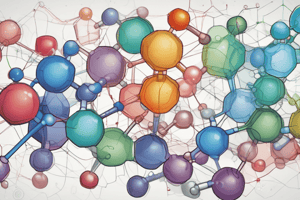Podcast
Questions and Answers
Which of the following is a criterion for determining the aromaticity of a compound?
Which of the following is a criterion for determining the aromaticity of a compound?
- Molecular weight
- Bond length (correct)
- Electronegativity
- Melting point
What type of strain is significantly present in small ring heterocycles?
What type of strain is significantly present in small ring heterocycles?
- Hydrogen strain
- Torsional strain (correct)
- Radial strain
- Thermal strain
Which pair of compounds is compared for their synthesis and reactions in relation to pyridinium salts?
Which pair of compounds is compared for their synthesis and reactions in relation to pyridinium salts?
- Hydrazines and diazines
- Thiazines and dithiocines
- Aziridines and oxetanes
- Pyrilium and thiapyrilium salts (correct)
Which of the following is a type of meso-ionic heterocycle?
Which of the following is a type of meso-ionic heterocycle?
What kind of reactions involve the synthesis of diazines and triazines?
What kind of reactions involve the synthesis of diazines and triazines?
Which heterocycle is characterized by having four membered rings?
Which heterocycle is characterized by having four membered rings?
In the context of small ring heterocycles, which interaction is most emphasized?
In the context of small ring heterocycles, which interaction is most emphasized?
Which of the following statements about the properties of aromatic heterocycles is incorrect?
Which of the following statements about the properties of aromatic heterocycles is incorrect?
Flashcards
Aromatic Heterocycle
Aromatic Heterocycle
Cyclic compound with a delocalized pi electron system that satisfies Hückel's rule and exhibits special stability.
Hückel's Rule
Hückel's Rule
A rule stating that a planar, cyclic, and conjugated molecule with (4n+2) pi electrons is aromatic.
Pyridine
Pyridine
Six-membered aromatic heterocycle containing a single nitrogen atom.
Pyran
Pyran
Signup and view all the flashcards
Pyrrole
Pyrrole
Signup and view all the flashcards
Furan
Furan
Signup and view all the flashcards
Diazine
Diazine
Signup and view all the flashcards
Thiazine
Thiazine
Signup and view all the flashcards
Study Notes
Heterocyclic Nomenclature
-
Heterocyclic compounds are named using the systematic IUPAC nomenclature.
-
Monocyclic fused and bridged heterocycles are named using substitutive and/or additive nomenclature.
-
Aromatic heterocycles conform to general aromatic rules.
Aromatic Heterocycles
-
Aromatic heterocycles exhibit typical aromatic behaviour with respect to structure, reactivity, and spectroscopic properties.
-
Classification, spectroscopic properties (e.g., NMR, UV-Vis), aromatic criteria (e.g., resonance energy, delocalisation energy, magnetic susceptibility).
-
Reactivity and tautomerism in aromatic heterocycles.
Non-Aromatic Heterocycles
-
Small ring heterocycles exhibit strain-induced properties from bond angles and torsional strain.
-
Ring inversions and pyramidal inversions are relevant in small ring heterocycles.
Medium-Sized Heterocycles
-
Synthesis and reactions of three- and four-membered heterocycles (e.g., aziridines, oxiranes, thiiranes, etc.).
-
Synthesis and reactions of benzo-fused five-membered heterocycles (e.g., benzopyrroles, benzofurans, benzothiophenes) including medicinal applications.
Mesoionic Heterocycles
- Classification and properties of mesoionic heterocycles (e.g., types A and B).
Six-Membered Heterocycles with a Heteroatom
- Synthesis and reactions of pyridinium salts, pyrones, quinolinium salts, benzo-fused heterocycles (e.g., coumarins, chromones).
Heterocycles with Multiple Heteroatoms
-
Synthesis and reactions of larger (seven or more membered) heterocyclic systems with two or more heteroatoms (e.g., diazines, triazines, tetraazines, thiazines).
-
Synthesis and reactions of larger heterocyclic compounds (e.g. azepinens, oxepins, thiepins, diazepines, thiazepines, azocines, diazocines, dioxocines, dithiocines).
Heterocycles Containing Arsenic, Antimony, and Boron
- Introduction, nomenclature, synthesis, and properties of heterocycles containing arsenic, antimony, and boron.
Studying That Suits You
Use AI to generate personalized quizzes and flashcards to suit your learning preferences.




